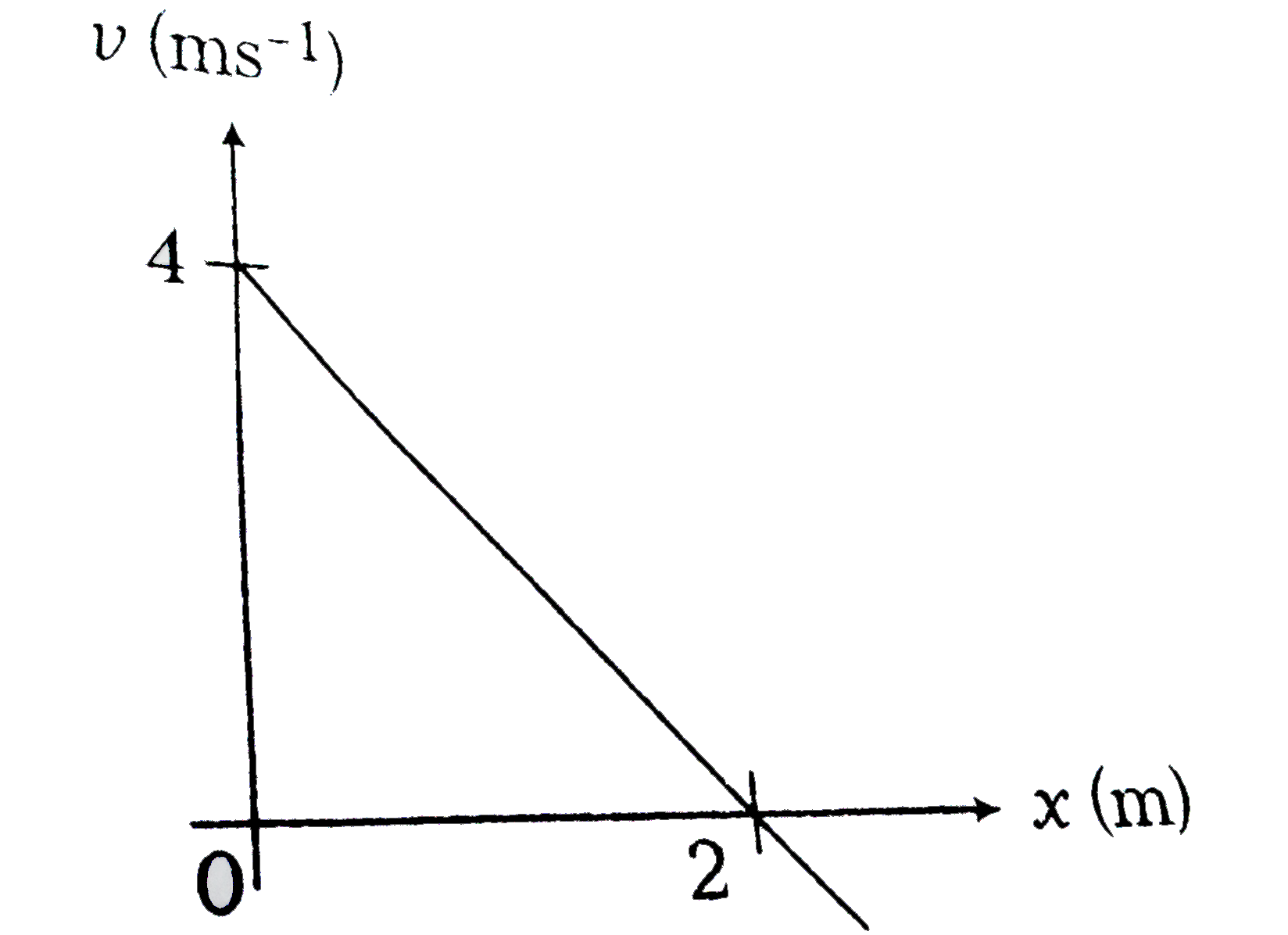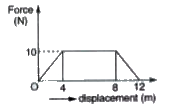Force F on the particle of mass 0.1 kg varies with distance x as shown in figure . If particle with distance x as shown in figure .If particle move from rest x = 0 , that at x = 12 cm , what will be its velocity ?
 Solution in Gujrati
Solution in Gujrati
Work W = Area of isoscles trapezoid OABC
=12{sum of sidesof parallelogram}×{perpendicular distancebetween sides of parallelogram}
=12(AB+OC)×(BD)
=12(4+12)×(10)
=80J
⇒ Now according to work energy theorem ,
W=Kf−K0
∴80=12mv2f−12mv2i
∴80=12mv2f [∴vi=0]
80=12×0.1×v2
∴1600=v2
∴v=40m−1
Topper's Solved these Questions
- WORK, ENERGY AND POWER BOOK - KUMAR PRAKASHANCHAPTER - WORK, ENERGY AND POWER EXERCISE - SECTION - C Objective Questions (VSQs)
52 Videos
- WORK, ENERGY AND POWER BOOK - KUMAR PRAKASHANCHAPTER - WORK, ENERGY AND POWER EXERCISE - SECTION - D NCERT Exemplar Solutions (Multiple Choice Questions)
21 Videos
- WORK, ENERGY AND POWER BOOK - KUMAR PRAKASHANCHAPTER - WORK, ENERGY AND POWER EXERCISE - SECTION - B Numericals (Numerical From Textual Exercise)
42 Videos
- WAVESBOOK - KUMAR PRAKASHANCHAPTER - WAVESEXERCISE - SECTION-F (Questions From Module) (Sample questions for preparation of competitive exams)
23 Videos
Similar Questions
If →A=2ˆi−2ˆjand→B=2ˆk then →A.→B……
View SolutionAn electron and a proton are moving under the influence of mutual forces . In calculating the change in the kinetic energy of the system during motion , one ignores the magnetic force of one on another . This is , because
View SolutionThe sign of work done by a force on a body is important to understand .State carefully if the following quantities are positive or negative :
(a) work done by a man in lifting a bucket out of a well by means of a rope tied to the bucket .
(b) work done by gravitational force in the above case ,
(c ) work done by friction on a body siding down an inclined plane ,
(d ) workdone by an applied force on a body moving on a rough horizontal plane woth uniform velocity .
(d) work done by the resistive force of air on a vibrating pendulum in bringing it to rest .
View SolutionIn a standing wave formed by two atoms separated by 1.21Å, there are 3 nodes and 2 antinodes. Find its wavelength.
View SolutionA particle of mass 0.1 kg is subjected to a force which varies with distance as shown in figure. If it starts its journey from rest at x=0 , its velocity at x=12m is
View SolutionThe velocity (υ) of a particle moving along X-axis varies with its position x as shown in figure. The acceleration (a) of particle varies with position (x) as

View SolutionA force F acting on a particle varies with the position x as shown in figure. Find the work done by this force in displacing the particle from

View SolutionForce acting on a particle varies with x as shown in figure. Calculate the work done by the force as the particle moves from x = 0 to x = 6.0 m.
View SolutionForce F on a particle moving in a straight line varies with distance d as shown in figure The work done on the particle during its displacement of 12 m is
View SolutionA particle of mass 0.1 kg is subjected to a force which varies with distance as shown in figure.

If it starts its journey from rest at x = 0, its velocity at x=12 m is
View SolutionA particle of mass 0.1 kg is subjected to a force which varies with distance as shown in figure. It starts its journey from rest at x=0, then its velocity at x=12 m is
View SolutionA particle of mass 0.1 kg is subjected to a force which varies with distance as shown in figure. It starts its journey from rest at x=0, then its velocity at x=12 m is

View SolutionA particle of mass 0.1 kg is subjected to a force which varies with distance as shown in figure. If it starts its journey from rest at x = 0, its velocity at x = 12 m is

View SolutionForce F on a particle moving in a straight line varies with distance d as shown in figure. The work done on the particle during its displacement of 12 m is

View SolutionThe velocity (upsilon) of a particle moving along X-axis varies with its position x as shown in figure. The acceleration (a) of particle varies with position (x) as
View Solution
